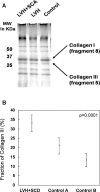Vulnerable myocardial interstitium in patients with isolated left ventricular hypertrophy and sudden cardiac death: a postmortem histological evaluation
- PMID: 23130141
- PMCID: PMC3487319
- DOI: 10.1161/JAHA.112.001511
Vulnerable myocardial interstitium in patients with isolated left ventricular hypertrophy and sudden cardiac death: a postmortem histological evaluation
Abstract
Background: Concentric left ventricular hypertrophy (LVH) is independently associated with increased risk of sudden cardiac death (SCD). Some animal models of LVH display specific alterations of the myocardial interstitium that could increase myocardial vulnerability to ventricular arrhythmias, but these merit evaluation in humans with LVH and SCD.
Methods and results: Twelve consecutive patients with isolated LVH and SCD (LVH+SCD) in the absence of hypertrophic cardiomyopathy, coronary disease, or other cardiac structural abnormality were ascertained in the Oregon Sudden Unexpected Death Study. Detailed postmortem comparisons were conducted with 18 controls who had isolated LVH and unnatural deaths (Control Group A) and 6 controls who had structurally normal hearts and unnatural deaths (Control Group B). Postmortem left ventricular myocardial sections were obtained for measurement of collagen volume fraction, characterization of gap junctions, and quantification of collagen subtypes. Heart weight normalized to body weight was higher in LVH+SCD cases (6.9±1.2 g/kg) than in Control Group A (5.3±1.4 g/kg) and Control Group B (4.2±0.3 g/kg); P=0.001. Collagen volume fraction was also higher in LVH+SCD cases (3.1±0.4) than in Control Group A (2.3±0.4) and Control Group B (1.6±0.3); P=0.0002. The relative amount of collagen III was significantly higher in LVH+SCD cases (33.0±4.4%) than in Control Group A (20.9±4.3%) and Control Group B (13.4±3.5%); P=0.0001. There was an overall increase in the number of connexin 43-labeled gap junctions with increasing myocyte size. No subject was found to have high-risk hypertrophic cardiomyopathy mutations.
Conclusions: In addition to the expected increase in myocardial mass and overall collagen content, SCD with isolated LVH was associated with relative abundance of type III collagen, a novel finding that warrants further mechanistic evaluation. (J Am Heart Assoc. 2012;1:e001511 doi: 10.1161/JAHA.111.001511.).
Keywords: collagen; death, sudden; hypertrophy; myocardium; remodeling.
Figures





Similar articles
-
Electrocardiographic predictors of sudden cardiac death in patients with left ventricular hypertrophy.Ann Noninvasive Electrocardiol. 2013 May;18(3):225-9. doi: 10.1111/anec.12003. Epub 2012 Nov 22. Ann Noninvasive Electrocardiol. 2013. PMID: 23714080 Free PMC article.
-
Acute restraint stress provokes sudden cardiac death in normotensive rats and enhances susceptibility to arrhythmogenic effects of adrenaline in spontaneously hypertensive rats.Leg Med (Tokyo). 2016 Jul;21:19-28. doi: 10.1016/j.legalmed.2016.05.003. Epub 2016 May 12. Leg Med (Tokyo). 2016. PMID: 27497329
-
T1 measurements identify extracellular volume expansion in hypertrophic cardiomyopathy sarcomere mutation carriers with and without left ventricular hypertrophy.Circ Cardiovasc Imaging. 2013 May 1;6(3):415-22. doi: 10.1161/CIRCIMAGING.112.000333. Epub 2013 Apr 2. Circ Cardiovasc Imaging. 2013. PMID: 23549607 Free PMC article.
-
Hypertension, left ventricular hypertrophy, and sudden cardiac death.Int J Cardiol. 2017 Jun 15;237:60-63. doi: 10.1016/j.ijcard.2017.03.002. Epub 2017 Mar 3. Int J Cardiol. 2017. PMID: 28285801 Review.
-
Left ventricular hypertrophy and sudden cardiac death.Heart Fail Rev. 2022 Mar;27(2):711-724. doi: 10.1007/s10741-021-10134-5. Epub 2021 Jun 28. Heart Fail Rev. 2022. PMID: 34184173 Review.
Cited by
-
Clinical Diagnosis of Electrical Versus Anatomic Left Ventricular Hypertrophy: Prognostic and Therapeutic Implications.Circ Arrhythm Electrophysiol. 2016 Apr;9(4):e003629. doi: 10.1161/CIRCEP.115.003629. Circ Arrhythm Electrophysiol. 2016. PMID: 27009417 Free PMC article. Review. No abstract available.
-
Translational research of adult stem cell therapy.World J Cardiol. 2015 Nov 26;7(11):707-18. doi: 10.4330/wjc.v7.i11.707. World J Cardiol. 2015. PMID: 26635920 Free PMC article. Review.
-
Sudden death in heart failure with preserved ejection fraction and beyond: an elusive target.Heart Fail Rev. 2019 Nov;24(6):847-866. doi: 10.1007/s10741-019-09804-2. Heart Fail Rev. 2019. PMID: 31147814 Review.
-
Increased left ventricular mass as a predictor of sudden cardiac death: is it time to put it to the test?Circ Arrhythm Electrophysiol. 2013 Feb;6(1):212-7. doi: 10.1161/CIRCEP.112.974931. Circ Arrhythm Electrophysiol. 2013. PMID: 23424223 Free PMC article. Review. No abstract available.
-
The Role of Long Non-Coding RNAs in Cardiovascular Diseases.Int J Mol Sci. 2023 Sep 7;24(18):13805. doi: 10.3390/ijms241813805. Int J Mol Sci. 2023. PMID: 37762106 Free PMC article. Review.
References
-
- Haider AW, Larson MG, Benjamin EJ, Levy D. Increased left ventricular mass and hypertrophy are associated with increased risk for sudden death. J Am Coll Cardiol. 1998;32:1454-1459 - PubMed
-
- Levy D, Anderson KM, Savage DD, Balkus SA, Kannel WB, Castelli WP. Risk of ventricular arrhythmias in left ventricular hypertrophy: the Framingham Heart Study. Am J Cardiol. 1987;60:560-565 - PubMed
-
- Fishman GI, Chugh SS, Dimarco JP, Albert CM, Anderson ME, Bonow RO, Buxton AE, Chen PS, Estes M, Jouven X, Kwong R, Lathrop DA, Mascette AM, Nerbonne JM, O'Rourke B, Page RL, Roden DM, Rosenbaum DS, Sotoodehnia N, Trayanova NA, Zheng ZJ. Sudden cardiac death prediction and prevention: report from a National Heart, Lung, and Blood Institute and Heart Rhythm Society Workshop. Circulation. 2010;122:2335-2348 - PMC - PubMed
Grants and funding
LinkOut - more resources
Full Text Sources
Miscellaneous

